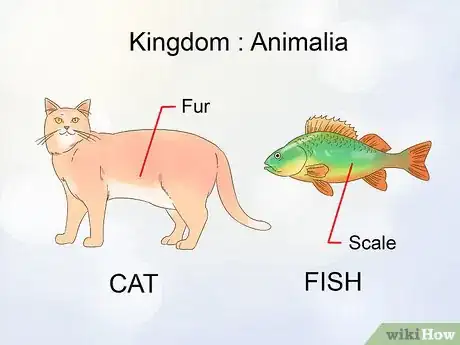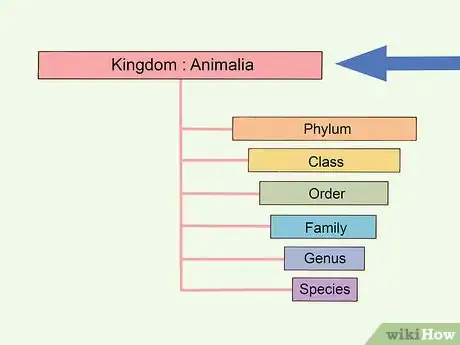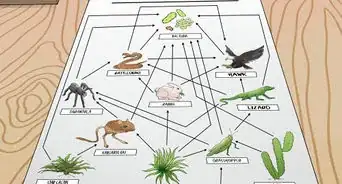wikiHow is a “wiki,” similar to Wikipedia, which means that many of our articles are co-written by multiple authors. To create this article, 27 people, some anonymous, worked to edit and improve it over time.
There are 7 references cited in this article, which can be found at the bottom of the page.
This article has been viewed 112,951 times.
Learn more...
From the humblest jellyfish to the most advanced primates, the animal kingdom houses an extremely diverse selection of organisms. It is estimated that between 9 and 10 million unique species of animals exist on Earth.[1] To organize such an enormous spectrum of diversity, biologists use a system of classification involving stratified "ranks" that group animals according to their similarity. With practice, navigating this system is no problem!
Steps
Understanding a Taxonomy Table
| Rank | Description | Examples |
|---|---|---|
| Kingdom | The largest of the traditional taxonomic ranks. Divides life into broad, inclusive categories. | Animalia, Plantae, Bacteria |
| Phylum | Large groupings dividing members of a kingdom into categories based on certain broad structural and genetic similarities. | Chordata, Magnoliophyta, Proteobacteria |
| Class | Medium-level grouping further dividing members of a phylum into more-specific categories based on body plan, common ancestry, etc. | Mammalia, Magnoliopsida, Gamma Proteobacteria |
| Order | Grouping dividing members of a class into sub-groups, members of which share specific, definitive features and common ancestry. The general name for a group of animals often comes from its order rank - e.g., members of order Primates are often collectively called "monkeys". | Primates, Rosales, Enterobacteriales |
| Family | Fairly specific grouping - divides members of an order into logical, recognizable groups of related organisms. Family names often end it "ae". | Hominidae, Rosaceae, Enterobacteriaceae |
| Genus | Specific grouping which divides members of a family into compact groups of closely-related organisms. Nearly all genera's members are direct descendants of a single common ancestor. Genus name forms first part of an organism's scientific name, always put in italics. | Homo, Rubus, Escherichia |
| Species | Most-specific classification. Species rankings refer to an exact, specific group of organisms which are essentially identical in terms of morphology. Only members of the same species can breed to produce viable offspring. Species name forms second part of an organism's scientific name and is always in italics. | sapiens, rosifolius, coli |
-
1Learn about the taxonomic classification systems used for identifying animals. This system for classifying animals based on their characteristics was originally derived from the 18th-Century work of botanist Carl Linnaeus.[2] However, generally, when biologists speak of taxonomic ranks, they refer to the seven "main" ranks, listed in the table below below from most inclusive to most exclusive. Note that the entries in the "Examples" column are color-coded to show the taxonomic "path" of classifying three example organisms.
- The entries in red follow the path of Homo sapiens, or humans (an animal).
- The entries in blue provide the example of Rubus rosifolius, or the West Indian Raspberry (a plant).
- The entries in green are an example of Escherichia coli, commonly known as E. coli (a bacterium).
-
2Memorize the mnemonic "King Phillip Came Over For Gimlets Saturday" to remember the taxonomic ranks. A variety of mnemonics, including this one, are useful for remembering the seven main taxonomic ranks - kingdom, phylum, class, order, family, genus, and species - and their order. The first letter of each word in the mnemonic corresponds to the first letter of each taxonomic rank in order. In other words, "King" corresponds with "kingdom", "Phillip" corresponds with "phylum", and so on.Advertisement
-
3Move from inclusive to exclusive when classifying. For example, every animal can be classified under the kingdom Animalia, but only a very specific animal fits into the species "Homo sapiens". As you move through each ranking from kingdom all the way down to species, any animal you classify will need to meet more and more requirements to be classified in a given category.
-
4Classify an animal based on its morphology. One large part of classifying an animal is identifying its morphology. Morphology refers to the internal and external characteristics of an animal. For example, does it have fur or scales? What kind of stomach does it have? Knowing about the characteristics of the animal you want classify will help you do this correctly.
Assigning a Taxonomic Classification
-
1Start in the kingdom Animalia. All animals are, by definition, members of the kingdom Animalia (sometimes also called "Metazoa").[3] All organisms within the kingdom are animals and all organisms outside of the kingdom are not animals. Thus, when classifying animals, you will always be working within this large "umbrella" category.
- Besides Animalia, the other taxonomic kingdoms include Plantae (plants), Fungi (fungi), Protista (single-celled eukaryotes), and Monera (prokaryotes).
- As a running example, let's try to classify anatomically modern humans according to the rules of taxonomic classification. Humans are living, breathing animals, so we'll start in kingdom Animalia, as directed above.
-
2Assign your animal a phylum. Phylum (plural: phyla) is the rank directly beneath the umbrella category of the kingdom Animalia. There are 35 different phyla in the kingdom Animalia. Very roughly speaking, each phylum groups its members according to general morphology. For instance, members of the phylum Chordata all have a stiff rodlike structure running along the length of its body (e.g. a backbone), with a hollow dorsal nerve cord above and a gut below, while members of the phylum Echinodermata all have five-pointed radial symmetry and a trademark "spiny" skin.
- Be aware that taxonomic ranks were created before the advent of modern genetics technology. Therefore, incongruities between organisms grouped together in a phylum and their actual genetic similarities can exist. This means that certain phyla have given rise to others. For example, Platyhelminthes (flatworms) giving rise to animal phyla with a through-gut.
- In our example, we would classify humans in the phylum Chordata, because we have a hollow dorsal nerve cord above a backbone.
-
3Assign your animal a class. After the phylum ranking comes an animal's class ranking. Across all the animal phyla, there are 111 different classes in total. Generally, the members of a class are grouped together based on their genetic and/or morphological similarities. Below are a few examples of classes within the phylum Chordata:
- Mammalia (mammals) - warm-blooded, with hair, a four-chambered heart, and mammary glands for secreting milk. Usually (but not always) give live birth.[4]
- Aves (birds) - warm-blooded, egg-laying, with a four-chambered heart, feathers and wings.
- Reptilia (reptiles) - cold-blooded, egg-laying, with scales or scutes and (usually) three-chambered hearts.[5]
- Amphibia (amphibians) - cold-blooded with three-chambered hearts and (usually) a water-bound larval life cycle, water-permeable eggs, and a skin that functions as a respiratory organ.[6]
- In addition, within the phylum Chordata, a relatively large number of classes for fish and fish-like organisms exist. The fish are:
- Osteichthyes - bony fish (ray-finned and fleshy-finned fishes)
- Chondrichthyes - cartilaginous fish (sharks, skates, dogfish, and rays)
- Agnatha - jawless fish (lampreys and hagfish)
- In our example, we would group humans in the class Mammalia because we exhibit the characteristics listed above.
-
4Assign your animal an order. After the class ranking comes an animal's order. Orders are used to group animals into easily-managed groups that are more specific than the inclusive blanket terms of phylum and class but less specific than genus, species, and so on. For example, the two orders within the class Reptilia are:[7]
- Testudines - turtles, tortoises, etc.
- Squamata - snakes and lizards
- In our example, we would classify humans in the order Primates, along with monkeys, apes, and our extinct proto-human predecessors.
-
5Assign your animal a family. After the order grouping, an animal's taxonomic classification begins to become fairly specific. For instance, a specific variety of animal's common name may be derived from the Latin root of its family name - geckos (members of the family Gekkonidae) are named this way. Another few examples of families within the order Squamata are:
- Chamaeleonidae - chameleons
- Iguanidae - iguanas
- Scincidae - skinks
- In our example, we would classify humans in the family Hominidae, along with the great apes and early proto-humans.
-
6Assign your animal a genus. An animal's genus (plural: genera) is used to differentiate it from other types of animals which may be superficially similar or even share the same common name. For instance, the members of the family Gekkonidae are all geckos, but members of the genus Dixonius (leaf-toed geckos) are different from the genus Lepidodactylus (scaly-toed geckos), and so on for all 51 genera in the family Gekkonidae.
- In our example, we would classify humans in the genus Homo, which includes modern humans and the types of early human ancestors that are familiar from popular culture - Neanderthals, Cro-Magnons, and so on.
-
7Assign your animal a species. An animal's species is usually the most specific taxonomic rank it can have. Species are often defined as, individuals that are similar in appearance, can breed amongst themselves, but are unable to breed with members of other species.[8] In other words, only animals that are in the same species can mate with each other and produce viable offspring. Animals that aren't in the same species can sometimes produce offspring, but these offspring are almost always sterile and cannot produce offspring of their own (one common example is the mule, which is unable to reproduce and is produced by breeding a horse and a donkey).
- Be aware that animals within the same species can appear to be different despite being closely related. For example, a chihuahua and a Great Dane look quite different, but are the same species.
- In our example, we would finally classify humans in the species Homo sapiens. This category excludes all other forms of life except for humans. Note that modern humans can have a wide variety of morphological differences - different size, facial appearance, skin color, hair color, and so on. Still, any male-female pair of healthy humans can produce viable offspring, so all modern humans are Homo sapiens.
-
8Assign your animal a subspecies, when necessary. As a general rule, an animal's species is the most specific classification it can receive. However, there are many exceptions to this rule in which scientists further subdivide a species of animals into two or more subspecies. A given species will always have two or more subspecies or none at all - never just one. A common situation in which subspecies classifications are assigned is if, within a species, certain groups of organisms are capable of producing viable offspring but do not do so in nature do to geographical separation, behavior patterns, or other reasons.
- In our example, if we want to refer to anatomically modern humans (i.e., the type of humans that inhabit the world today), we can use the subspecies Homo sapiens sapiens to further differentiate ourselves from Homo sapiens idaltu, another type of proto-human in the Homo sapiens species.
Classifying an Animal Based on its Scientific Name
-
1Start with an animal's scientific name. The final two taxonomic ranks, genus and species, which are the most specific of all the ranks, are used for an animal's scientific name. In other words, an animal's official name by which it is recognized by scientists worldwide is its Genus (capitalized) followed by its species (not capitalized). For example, the scientific name of modern humans is Homo sapiens because they belong to the genus Homo and the species sapiens. Note that an animal's scientific name is italicized.
- Because an animal's genus and species are its most specific taxonomic classifications, often, this will be sufficient classification information for most purposes.
- If you do not know the scientific name of the animal you are interested in classifying, try searching the internet. Search for the common name of the animal (e.g. "dog") along with "scientific name". You will be able to quickly find the scientific name this way.
-
2Use the animal's scientific name as a starting point for research. Because an animal's scientific name is its genus and species, if you know an animal's scientific name, you usually have enough information to find the rest of its taxonomic ranks by using these two as a starting point.
-
3Work backwards through the each group using inference. Once you know an animal's scientific name, it's also possible to determine an animal's taxonomic classifications through inference, using your animal's morphology, evolutionary history, and genetic relationships to other animals to choose its family, order, and so on. Use information you know about the species to aid your search. If possible, double-check your inferences in a suitable biological resource or textbook.
- For instance, in our Homo sapiens example, we know that humans share a recent evolutionary ancestor with other great apes (chimpanzees, gorillas, and orangutans), which means they both belong to the same famil (in this case, the hominids or Hominidae). Since great apes are primates, we can place Homo sapiens in the order Primates as well. From here, class and phylum are easy. Obviously, all primates are mammals, so we can say that humans are in the class Mammalia as well, and since mammals have backbones, they also belong in the phylum Chordata.
- As mentioned at the beginning of the article, all animals will be in Kingdom Animalia regardless of their other taxonomic classifications.
References
- ↑ http://animaldiversity.ummz.umich.edu/accounts/Animalia/
- ↑ http://www.ucmp.berkeley.edu/history/linnaeus.html
- ↑ http://animaldiversity.ummz.umich.edu/accounts/Animalia/
- ↑ http://www.thefreedictionary.com/class+Mammalia
- ↑ http://www.thefreedictionary.com/class+Reptilia
- ↑ http://www.thefreedictionary.com/class+Amphibia
- ↑ http://imnh.isu.edu/digitalatlas/bio/reptile/main/reptilia.htm
- ↑ http://dictionary.reference.com/browse/species
About This Article
To classify an animal, start by identifying its kindgdom, which is Animalia for all animals. Then, assign your animal a phylum, like chordata, followed by a class, like mammals or birds. You’d then want to find the animal’s order, such as primate. Once you find the order, group the animal into a family, like hominidae, and then into a genus, such as homo or rubus. Finally, note the animal’s species, which is the most specific classification. To learn how to classify an animal based on its scientific name, keep reading!






































































